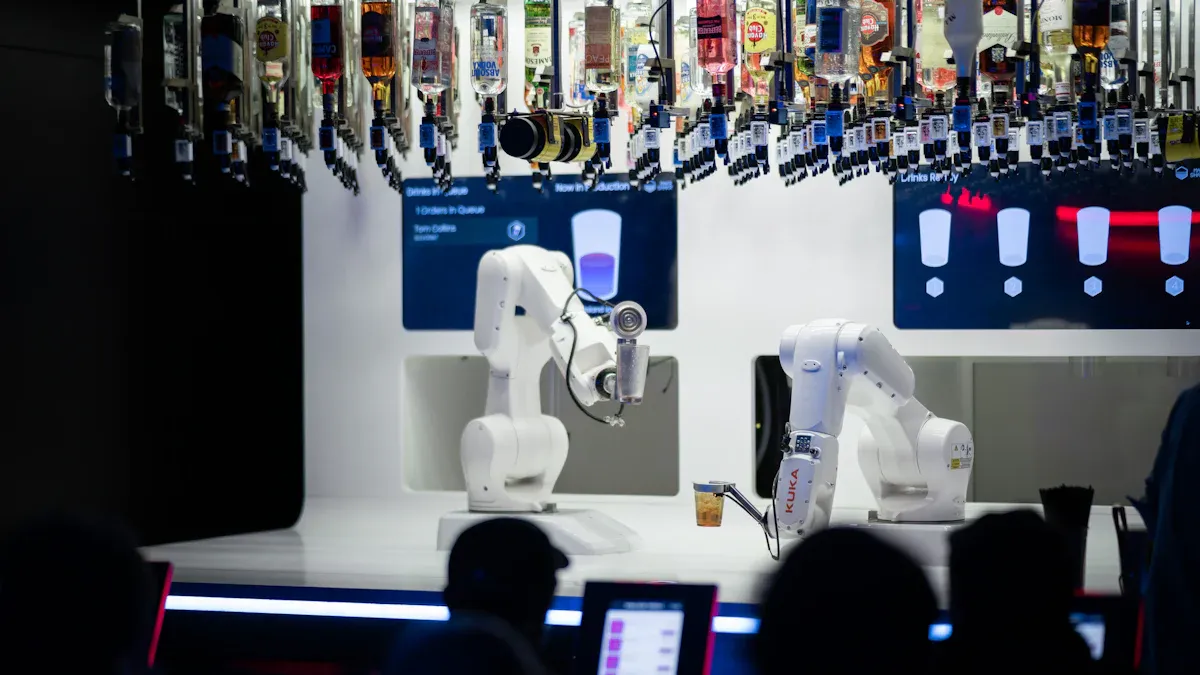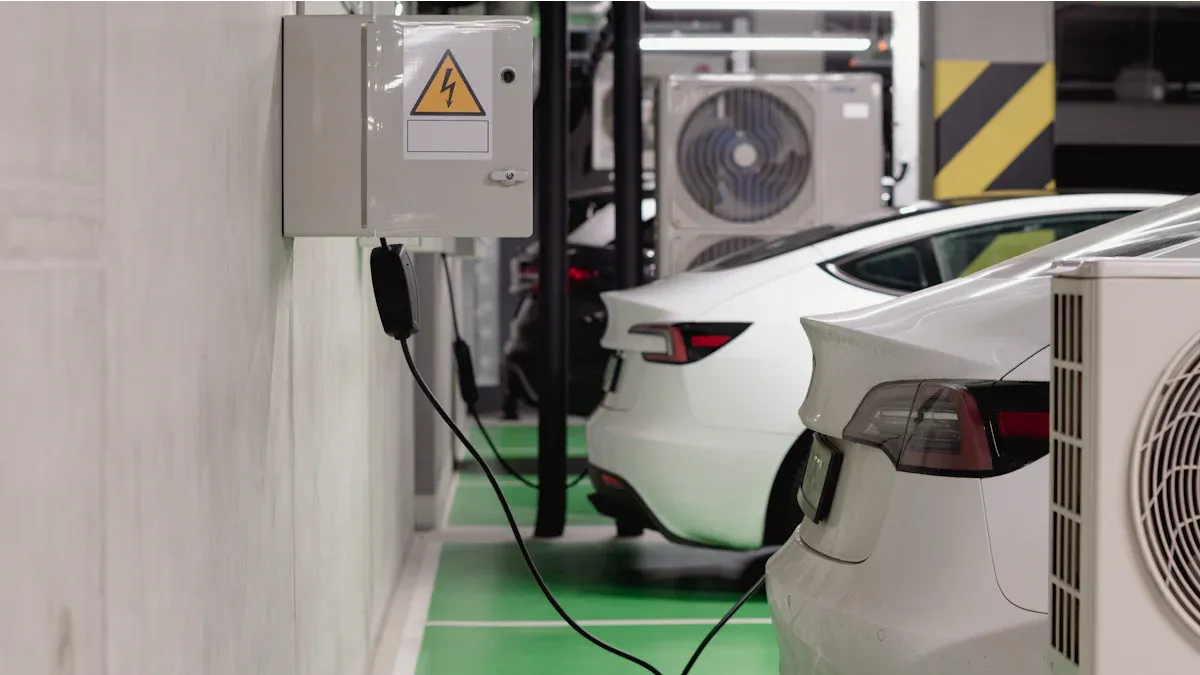
You demand robots that never stop. The uninterruptible robot meets this challenge, running around the clock in mission-critical environments. Autonomous battery-changing systems now let machines swap power sources without human help. Lithium battery technology drives this progress by delivering long-lasting, steady power and rapid charging, keeping your operations seamless.
Key Takeaways
Hot-swappable battery systems allow robots to replace batteries without stopping, ensuring continuous operation and minimizing downtime.
Using lithium batteries enhances performance with high energy density and fast charging, making robots more efficient in demanding environments.
Autonomous battery-changing systems improve operational efficiency, enabling robots to work 24/7 and adapt to task urgency without human intervention.
Part 1:Uninterruptible Robot Systems

1.1 Hot-Swappable Battery Basics
You need your uninterruptible robot to keep working, even when the battery runs low. Hot-swappable battery systems make this possible. These systems let you replace a depleted battery with a charged one while the robot stays powered and operational. You avoid downtime and keep your workflow moving.
Here’s a quick overview of the core engineering principles behind hot-swappable battery systems:
Principle | Description |
|---|---|
Continuous Operation | Hot-swappable batteries allow for replacement without powering down, enabling uninterrupted work. |
Self-Swapping Mechanism | The robot is designed to autonomously swap its batteries, enhancing operational efficiency. |
Dual Battery Packs | The presence of twin removable battery packs ensures one is always available to power the robot. |
You benefit from a system that supports continuous operation. The robot can use an autonomous self-swapping mechanism to change its own battery. With dual battery packs, one battery always powers the robot while the other charges or waits for use. This setup keeps your robot running without interruption.
Tip: Hot-swapping capabilities allow you to replace discharged batteries while the robot remains operational, ensuring continuous functionality.
1.2 System Design Principles
You want a system that delivers reliability and safety. Engineers design hot-swappable battery systems with several key principles in mind:
Redundant power sources ensure your robot never loses power during a battery change.
The system uses intelligent control to manage the battery swap process, preventing accidental shutdowns.
Mechanical guides and locking mechanisms guarantee precise alignment and secure connections during battery changing.
Sensors monitor battery status and system health, alerting you to any issues before they affect performance.
Engineers address the risk of power interruption by using advanced battery technology. For example, a dual-battery system enables seamless hot swapping and power balancing. The robot can autonomously change its battery in just a few minutes. This approach lets your robot choose between swapping batteries or charging, depending on workload and urgency. You maintain operational efficiency and avoid costly downtime.
1.3 Lithium Battery Integration
You rely on lithium battery technology for its high energy density, fast charging, and long cycle life. When integrating lithium batteries into your hot-swappable system, you must consider several factors:
Battery Voltage and Capacity: Match the battery to your robot’s operating voltage and runtime needs.
Battery Size and Weight: Ensure the battery fits your robot’s design and does not hinder mobility.
Discharge Current: Choose a battery that can handle your robot’s peak energy demands.
Battery Lifespan: Select chemistries like LiFePO4 for frequent charge-discharge cycles and long service life.
Environmental Compatibility: Use batteries rated for your robot’s operating temperature and environment.
Safety Features: Look for built-in protection circuits to guard against over-voltage, under-voltage, over-current, and overheating.
Communication Protocol: Ensure compatibility with your robot’s communication system, such as CAN or RS485.
Hot-Swappable Batteries: This feature allows you to change batteries without powering down, minimizing downtime.
Multi-Battery Parallel Capability: Connect multiple batteries to expand energy capacity and runtime.
Modular battery systems enable you to upgrade or replace batteries without taking your robot offline. This flexibility extends the operational life of your platform and lets you adopt new battery technologies as they become available.
Battery Chemistry | Platform Voltage (V) | Energy Density (Wh/kg) | Cycle Life (cycles) |
|---|---|---|---|
Lithium-ion | 3.6 | 150-250 | 500-1,500 |
LiFePO4 | 3.2 | 90-160 | 2,000-5,000 |
NMC | 3.7 | 150-220 | 1,000-2,000 |
LCO | 3.7 | 150-200 | 500-1,000 |
LMO | 3.7 | 100-150 | 300-700 |
LTO | 2.4 | 70-80 | 7,000-20,000 |
Solid-state | 3.7 | 250-350 | 1,000-10,000 |
You gain several safety and performance benefits from lithium batteries in hot-swappable applications:
Fault warning systems and intelligent charging management help prevent equipment failure and safety hazards.
High energy density and fast charging improve operational uptime.
Good temperature adaptability ensures reliability in various conditions.
Note: If your application involves medical, robotics, security, infrastructure, consumer electronics, or industrial environments, always verify that your battery system meets the relevant safety and regulatory standards.
Part 2:Battery Engineering and Safety
2.1 Electrical Isolation
You need robust electrical isolation to guarantee safe battery swaps in your uninterruptible robot. Engineers use two primary methods to achieve this: diodes and FET-controlled circuits. Diodes provide effective isolation, especially in high-voltage applications, but they introduce a voltage drop that can reduce system performance. FET-controlled circuits and ideal diode ICs minimize this voltage drop, which improves efficiency and extends runtime. These solutions allow you to replace batteries safely without risking electrical faults or damaging sensitive components.
Industry standards set strict requirements for electrical isolation in hot-swappable battery systems. You must ensure your robotic platforms comply with these standards to maintain safety and reliability.
Standard | Description |
|---|---|
IEC 60695 | Assesses fire hazards in electrotechnical products. |
UL 94 | Measures flammability of plastic materials exposed to flame. |
IEC 62933 | Focuses on safety aspects in battery energy storage systems. |
UL 1973 | Outlines safety specs for insulation materials in battery modules. |
IEC 62619 | Ensures safety of lithium-ion cells in battery energy storage systems. |
UL 9540 | Comprehensive standard for electrical isolation and fire protection. |
Tip: Always verify that your autonomous battery-changing system meets these standards before deployment. This step protects your investment and ensures compliance with regulatory requirements.
2.2 Power Management
You rely on advanced power management strategies to maintain continuous operation during battery swaps. Your system uses autonomous battery swap technology, which enables the robot to replace its battery in minutes without shutting down. Dual-battery systems switch to a backup battery if the main battery fails, ensuring critical tasks continue without interruption. Plug-and-play battery swap stations maximize uptime, allowing your robotic platforms to remain in service more than 99% of operating hours.
Feature | Description |
|---|---|
Autonomous Battery Swap | The robot completes battery replacement in 3 minutes, maintaining operation. |
Dual-Battery System | Switches to backup battery for uninterrupted performance. |
Continuous Operation | 24/7 operation boosts production efficiency. |
Battery swap stations enable high-capacity, automated battery exchange and charging for maximum uptime.
Robots can achieve sub-one minute battery swaps every two hours, resulting in over a 7% increase in utilization compared to traditional methods.
Your system benefits from hot swap functionality, which allows quick exchange of depleted batteries for fully charged ones. Advanced software algorithms predict state-of-power accurately, optimizing battery utilization and performance. Higher voltage systems, supporting up to 60V, suit a wide range of robotic applications and further reduce downtime.
Feature | Description |
|---|---|
Hot Swap Functionality | Quick exchange of batteries for continuous operation. |
Advanced Software | Accurate state-of-power predictions enhance performance. |
Higher Voltage Systems | Supports up to 60V for diverse robotic platforms. |
2.3 Mechanical Swap Design
You need a reliable autonomous battery-changing solution that integrates seamlessly with your robotic platforms. Modular mechanical design allows easy integration into various systems. Quick exchange processes enable fast battery swapping, minimizing downtime and maximizing efficiency. Advanced battery technology includes cell balancing and accurate state-of-charge indicators, which help maintain optimal performance.
Modular design fits different robotic platforms and applications.
Quick exchange mechanisms reduce swap time and keep robots operational.
Cell balancing and state-of-charge indicators support reliable battery management.
Battery swapping technology enables your robot to remove a depleted battery and replace it with a fully charged one in seconds. This process is designed for minimal interruption, ensuring your uninterruptible robot maintains peak efficiency throughout its operational cycle.
2.4 Control and Communication
You depend on precise control and communication protocols to coordinate autonomous battery swaps. Your system operates within a hybrid architecture, blending centralized planning with independent execution. Ultra-fast real-time communication protocols ensure accurate timing and adaptability to changing conditions. Two-way handshakes and heartbeat messages enhance reliability, allowing your robot to detect and respond to disruptions quickly.
Aspect | Description |
|---|---|
Coordination Architecture | Hybrid system blends centralized planning and independent execution. |
Real-time Communication | Ultra-fast protocols enable precise timing and adaptability. |
Reliability Techniques | Two-way handshakes and heartbeat messages improve reliability. |
Dynamic path planning lets robots adjust movements based on real-time awareness of teammates’ positions.
A central coordinator manages task assignments and prevents conflicts among robots.
Real-time simulation predicts operations and adjusts plans proactively.
Your autonomous battery-changing system leverages these protocols to maintain seamless operation and maximize uptime. Reliable communication ensures that your robotic platforms execute battery swaps efficiently, supporting continuous operation in demanding environments.
Part 3:Autonomous Battery-Changing System Applications

3.1 Real-World Use Cases
You see autonomous battery-changing systems transforming robotic platforms across industries. In medical robotics, custom solutions support continuous patient care and diagnostics. Security robots patrol facilities without interruption, while infrastructure inspection robots maintain bridges and tunnels with minimal downtime. Industrial platforms in manufacturing and logistics rely on these systems for 24/7 operation.
The Walker S2, developed by UBTECH, is the first humanoid robot capable of replacing its own battery without any human assistance. This robot can autonomously detect when its battery is low, navigate to a recharging station, and perform the battery change process using its articulated arms.
Ground-based robots and unmanned aerial vehicles benefit from robust autonomous battery swap solutions. You deploy these platforms in warehouses, factories, and outdoor environments where manual intervention is impractical. The Walker S2 stands out for its dual battery system, enabling it to replace batteries one at a time and maintain uninterruptible robot operation. This innovation sets a new standard for robotic platforms requiring continuous uptime.
3.2 Business Benefits
You maximize operational efficiency with autonomous battery-changing systems. These solutions reduce downtime and enhance the robustness of your robotic platforms. Smarter battery systems minimize interruptions and improve safety in logistics and manufacturing. You achieve higher operational uptime, which is critical for business success.
The Walker S2’s autonomous battery swap capability allows it to operate 24/7, unlike conventional robots that require manual battery changes or charging. The system enables real-time decision-making based on task urgency. Robots can choose between charging and changing batteries, ensuring continuous operation.
Robots like the UBTECH Walker S2 can autonomously replace their batteries in under three minutes.
The system enables real-time decision-making based on task urgency, allowing robots to choose between charging and swapping.
This capability ensures that robots can operate continuously without downtime.
Platform Type | Battery Change Process | Downtime Reduction | Continuous Operation |
|---|---|---|---|
Walker S2 Humanoid | Autonomous | High | Yes |
Ground-Based Robots | Autonomous | Moderate | Yes |
Unmanned Aerial Vehicles | Autonomous | Moderate | Yes |
You gain a competitive edge by deploying robotic platforms with autonomous battery-changing systems. These solutions support uninterrupted workflows and help you meet demanding business requirements. For a custom consultation on integrating lithium battery systems into your platforms.
You achieve uninterruptible robot operation by applying advanced engineering principles to hot-swappable battery systems.
Robots like Walker S2 swap batteries autonomously, supporting continuous industrial use.
Downtime drops, and 24/7 operations become possible in logistics and manufacturing.
Intelligent Battery Management Systems boost safety and reliability.
Smart energy solutions extend battery life and improve performance.
Hot-swappable batteries keep your robots running by charging backups while in use, reducing operational costs over time.
Attribute | Description |
|---|---|
Energy Density | Robots run longer on a single charge. |
Cycle Life | LiFePO4 batteries last over 2,000 cycles, lowering replacement needs. |
Safety and Stability | LiFePO4 batteries resist overheating, supporting safe continuous use. |
Fast Charging | Rapid recharging cuts downtime and raises efficiency. |
Environmental Friendliness | LiFePO4 batteries support sustainable practices. |
You prepare for a future where robotics and battery technology evolve together, driving efficiency and reliability in every business-critical application.
FAQ
How do you integrate Large Power lithium battery systems into industrial robots?
You select compatible modules from Large Power. You follow the integration guide. For a custom battery solution consultation, click here. You ensure seamless operation in industrial environments.
What safety standards should you follow for lithium battery systems in security or medical robots?
You comply with IEC 62619, UL 1973, and UL 9540. For security, medical and robotic applications, these standards ensure safe, reliable operation.
Can you customize lithium battery systems for different applications like infrastructure or consumer electronics?
Yes. You tailor battery voltage, capacity, and form factor for infrastructure or consumer electronics needs. See the table below for typical specifications:
Application | Platform Voltage (V) | Energy Density (Wh/kg) | Cycle Life (cycles) |
|---|---|---|---|
Infrastructure | 3.2–3.7 | 90–250 | 2,000–10,000 |
Consumer Electronics | 3.6–3.7 | 150–350 | 500–10,000 |
Tip: Consult with Large Power for optimal lithium battery solutions for your specific application.






